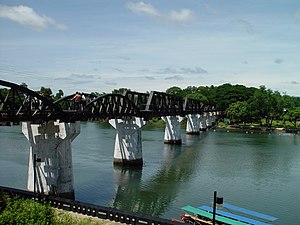Bridge over the River Kwai
Coordinates: 14 ° 2 ′ 27 ″ N , 99 ° 30 ′ 11 ″ E
| Bridge over the River Kwai | ||
|---|---|---|
| Bridge over the River Kwai | ||
| use | railroad | |
| Convicted | Thailand-Burma Railway of the Thai State Railways | |
| Crossing of | Mae Nam Khwae Yai ("Kwai") | |
| place | Kanchanaburi | |
| construction | Truss bridge | |
| overall length | 320 m | |
| Number of openings | 15th | |
| Longest span | 3 × 20.80 m, 2 × 32.50 m, 5 × 20.80 m, 6 × 15.35 m | |
| opening | 1944 | |
| construction time | 2 years | |
| location | ||
|
|
||
The bridge over the Kwai is a railway bridge on the Thailand-Burma Railway .
Geographical location
The bridge led over the Mae Nam Mae Klong (today: Mae Nam Khwae Yai ( Thai : แม่น้ำ แคว ใหญ่ , pronunciation: [mɛ̂ː náːm kʰwɛː jàj] ), "Great tributary"; or just Khwae Yai , internationally known as the River Kwai ). It is near Kanchanaburi . Here the Khwae Yai unites with the Khwae Noi and is called Mae Klong from then on .
history
prehistory
After the Japanese Empire occupied Thailand in World War II in 1942 , the Thai government came to terms with the occupiers and entered the war on the Japanese side. The Japanese generals sought to connect the Thai railways with those in Burma in order to avoid the long and risky sea transport around the Malay Peninsula , through the Straits of Malacca and around Singapore. She wanted to prepare strategically for the attack on British India .
Since the Japanese destroyed numerous documents in the immediate vicinity of their surrender, including those relating to the construction of the railway line and the bridge, many historical details about the construction activities on the Thailand-Burma railway are unclear.
construction
The route has been measured since February 1942 and preparations for construction have been made since March. Construction was ordered in June 1942 and the zero milestone was set in Nong Pladuk on July 5, 1942 . The construction of the route was essentially carried out by a large number of prisoners of war and forced labor . In early 1943 the line to Kanchanaburi was in operation.
The first “bridge over the Kwai” was built in the summer of 1943 for construction using wood. The details of the completion of the construction work on the bridge vary between May and September 1943. Later, when the relevant material had arrived from Japan, a second parallel bridge made of concrete and steel was built. In addition, a consisted ferry traffic at this point, is not known to whether he was or just before the completion of the first bridge in operation has also been used as a replacement in case of damage of the bridges.
business
Bridges were more difficult to repair than tracks or embankments and were therefore the preferred target of Allied attacks . This was particularly true for the bridge over the Kwai, which at 320 meters was the second longest in Thailand and was therefore easy to identify as a target for aircraft. In such attacks, both the wooden Kwai Bridge and the steel bridge 200 meters upstream were repeatedly damaged and then repaired. It is unclear whether the wooden bridge was torn down and rebuilt when the bombing attacks became more numerous, or whether the originally built wooden bridge remained standing. Most of the time, the Japanese managed to keep at least one of the bridges operational. When the funds to repair the steel bridge ran out, only the wooden bridge was repaired. When the damage from the air raids became too extensive, operations on the line had to be finally stopped in June 1945.
post war period
The steel bridge, of which three spans were ultimately destroyed, was rebuilt by a Japanese company after the war in 1946 and is now part of the railway line to Nam Tok . The wooden second bridge over the Mae Klong was demolished in 1946. In 1971 the steel bridge was repaired again.
celebrity
The bridge became world famous through the novel The Bridge on the Kwai by Pierre Boulle and its filming by David Lean .
Surname
The name of the bridge was incorrect: It led over the Mae Nam Mae Klong, while the railway line mostly ran along the Khwae Noi (in English "Kwai"). The bridge got its literary name from this river. To bring this in line, the upper reaches of the Mae Klong, above Kanchanaburi, was renamed Khwae Yai in the 1960s , so that the bridge now actually crosses a river called the Khwae ("Kwai").
Movies
- Die Brücke am Kwai (The Bridge on the River Kwai) , USA / GBR 1957, directed by David Lean
- To End All Wars (To End All Wars) , USA / GBR / THL 2001, directed by David L. Cunningham
literature
- JP [sic]: The True Story of the Death Railway and the Bridge on the River Kwai. [sic]. o. O. (edited by the Thailand-Burma Railway Center, Kanchanaburi), o. J. (approx. 2010), without ISBN.
- BR Whyte: The Railway Atlas of Thailand, Laos and Cambodia. White Lotus Co Ltd, Bangkok 2010, ISBN 978-974-480-157-9 .


